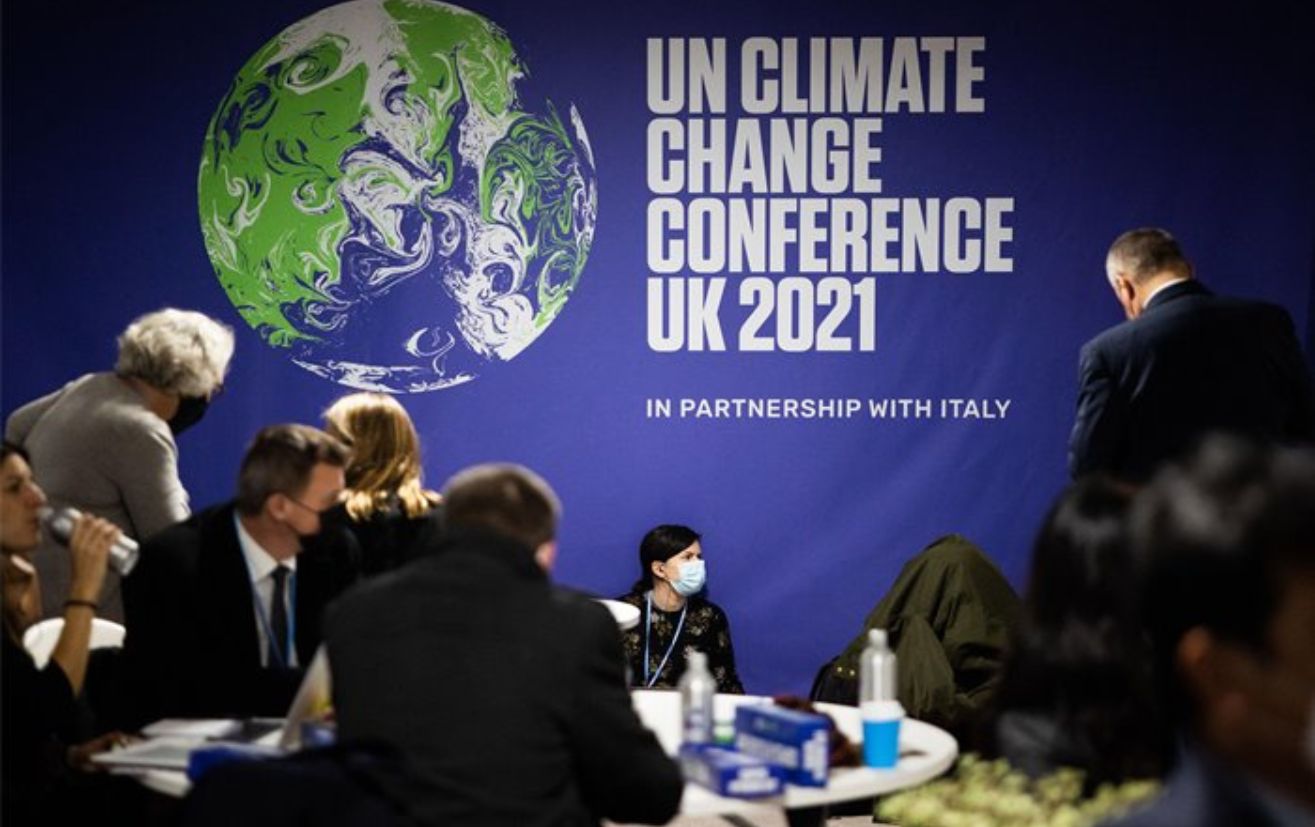
As the dust settles following the long-awaited COP26, many are evaluating the implications of the outcomes of the Glasgow Climate Change Conference and next steps. While there may not have been sufficient progress on all fronts, important steps forward were taken. The Glasgow Climate Pact reaffirms the Paris Agreement goal of limiting temperature rise to well below 2°C, recognizing that global climate impacts will be lower at 1.5°C warming. The Pact highlights that limiting global warming to 1.5°C requires reducing by 2030 relative global GHG emissions by 45% compared to the 2010 level and to net zero around mid-century. It also notes with serious concern that current nationally determined contributions (NDCs) fall drastically short of this target (with GHG emissions estimated to be 13.7% above the 2010 level in 2030), emphasizing the urgent need for enhanced ambition.
The completion of the Paris Rulebook, following agreement on several previously unresolved issues, is one major achievement at COP26. Notably, this includes agreement on Article 6, to operationalize use of international carbon markets in the context of the Paris Agreement. This consists of: (1) the guidance for voluntary cooperation through Article 6.2 cooperative approaches, including internationally transferred mitigation outcomes (ITMOs); (2) the rules, modalities and procedures that will govern the Article 6.4 mechanism established under the UNFCCC; and (3) further work on non-market approaches, via the establishment of a Glasgow Committee for non-market approaches (NMAs).
Resolution was finally found in Glasgow on what proved to be the most difficult issues to tackle in the context of carbon markets under Article 6 – issues which had prevented agreement at the previous two COPs, such as the relationship between the Kyoto Protocol mechanisms and the Article 6.4 mechanism as well as details on how to apply corresponding adjustments to avoid double-counting.
Several other key topics came to the forefront of the Article 6 negotiations during the two weeks. These included references to human rights and Indigenous Peoples and local communities and, finally, whether there would be explicit inclusion of REDD+.
Focusing in on REDD+, the scope under Article 6 includes both emission reductions and removals. A reasonable and generally agreed interpretation is that REDD+ activities meeting all other applicable Article 6 requirements are or will be implicitly eligible. However, as the crowds dispersed from Glasgow and returned to their desks to digest the technical details of the decisions – particularly the Article 6 decisions – varying interpretations have emerged regarding the role of REDD+ in Article 6 – with some saying it’s clearly eligible under Article 6, others saying it’s been excluded, and others noting it is not clear.
Why so much confusion around this particular aspect of the Article 6 decisions?
This confusion can partially be traced back to a very specific REDD+ proposal put forward by the Coalition for Rainforest Nations in Glasgow, which was added to earlier iterations of the draft Article 6 decision texts. This text proposed explicit inclusion of REDD+, more specifically, those REDD+ results reported to and technically analyzed through the UNFCCC process, and listed on the UNFCCC REDD+ Info Hub, which includes REDD+ results from as early as 2006.
It is broadly understood that for high-quality forest carbon markets, credits need to meet not only the Warsaw Framework for REDD+ requirements but also market-specific rules and provisions, including independent validation and verification by a third party, to ensure environmental and social integrity. Therefore, while the Warsaw Framework for REDD+ was not explicitly included in the final agreement, REDD+ per se is not excluded altogether, as several articles and blogs posted over the past weeks imply.
However, beyond the particular negotiation dynamics in Glasgow, there are other factors contributing to the confusion. To break it down, we need to look more closely at (1) the scope of REDD+ and (2) several specific text references in the final Article 6.2 and 6.4 decisions.
The full scope of REDD+ activities, as defined in the context of the UNFCCC is “reducing emissions from deforestation and forest degradation, plus conservation, enhancement of forest carbon stocks and sustainable management of forests”. Given that the definition of ITMOs includes both emission reductions and removals with no explicit inclusion or exclusion of specific sectors, and the specification that mitigation outcomes are generated from 2021 onwards, reducing emissions from deforestation and forest degradation as well as removals, or enhancement are REDD+ activities can become ITMOs. On this basis, we expect that high-quality jurisdictional-scale REDD+ programs that meet all of the other Article 6.2 requirements can be used by Parties to achieve their NDCs and other international mitigation purposes.
In the case of the 6.4 mechanism, there is critical forthcoming work, particularly the Supervisory Body’s review of eligible activities and methodologies, including those from the Clean Development Mechanism (CDM) as well as those related to “other market-based mechanisms,” which could include methodologies from private carbon standards used in the voluntary carbon markets (VCM). So, again, just as in Article 6.2, there has been no outright inclusion or exclusion of REDD+, but Article 6.4 differs because the Supervisory Body will actually decide what is, and is not, eligible.
There is, however, further consideration to be given to “emissions avoidance” for both Article 6.2 and 6.4, as well as to “conservation enhancement” for Article 6.4 specifically. We interpret these terms as potentially applicable only to specific REDD+ activities within the broader scope described above. There is no exact definition of “emissions avoidance” and an interpretation that automatically equates it to avoided deforestation does not have a strong basis. The use of “conservation enhancement” versus enhancement or removals more generally, points to a focus on ongoing removals in conserved forests, for which there have been specific questions raised, in terms of how to ensure additionality, i.e., going beyond what would have happened anyway.
Another key area that is also generating a lot of discussion is the impact of Article 6 decisions on VCM. Initiatives such as the Voluntary Carbon Market Integrity Initiative (VCMI) are working with technical experts and countries, to provide guidelines for claims that are made by private companies that buy voluntary carbon credits, to ensure its high integrity. These units, which do not have authorization from the national government to be discounted from their national accounting for the NDC, are certified and issued by international private standards and bought by various companies to meet their own voluntary targets as part of their corporate responsibilities. VCM will continue to be an important means for channeling private climate finance to NDC implementation moving forward. The total volume of VCM transactions as of August 31, 2021, had already exceeded $748 million. 2021 is likely to deliver the highest annual value ever tracked in the VCM, potentially exceeding $1 billion. Already a leading category in terms of volumes transacted, Forestry and Land Use posted a near-record volume in 2020 at 47 MtCO2e (the previous high was 50.7 MtCO2e in 2018) and set a new high price mark at $5.59/ton in 2020 (average prices were $3.40 in 2018 and $4.33 in 2019). While it is too early to tell what the long-term impact will be, there has already been an evident impact on price in the weeks following COP26[1]. VCM transactions will continue to exist outside the UNFCCC and it is critical to ensure these will be carried out with high integrity.
In the coming days and weeks, experts will continue to analyze and clarify the COP26 decisions and what they mean - particularly those on Article 6 - but one thing is already clear – we need to accelerate action and ambition. There is no time to lose. Many countries (85% of total) have already indicated their intent to use international carbon markets to achieve their updated or new NDCs. UNDP’s Climate Promise has been working since 2020 with more than 100 countries to support enhanced ambition and accelerate implementation of NDCs and is well positioned to continue to accompany countries in this process. Now that the Paris Rulebook has been finalized, we can move forward together with renewed momentum to ensure the Article 6 will achieve its objectives on higher ambition, environmental integrity and sustainable development.
[1] For more information: https://www.spglobal.com/platts/en/market-insights/latest-news/energy-transition/112321-cop26-confirms-role-of-voluntary-carbon-market-verra



